
* A bit less than a quarter of a billion years ago, following a global catastrophe that wiped out a good portion of life on Earth, the diapsids became the dominant large organisms on the planet, in the form of the "dinosaurs", as well as marine and flying species. The dinosaurs gave rise to the birds, which would survive in numbers to modern times. The same era saw the emergence of flowering plants and mammals.
* The Mesozoic era -- broken into the Triassic (beginning 240 million years ago), Jurassic (205 million years ago), and the Cretaceous (138 million years ago) periods -- is commonly referred to as the "age of the dinosaurs", but many of the reptilians of the era were not, technically speaking, dinosaurs. Indeed, some entirely familiar modern reptilians emerged early in the Mesozoic: perfectly recognizable turtles are known from the late Triassic. A somewhat older "proto-turtle" named Odontochelys has been recently found, with an expanded, reinforced rib cage much like that of a modern turtle -- but lacking a modern turtle's back armor, which is an extension of the turtle's spine. Odontochelys clearly represents an intermediate form towards a true turtle.
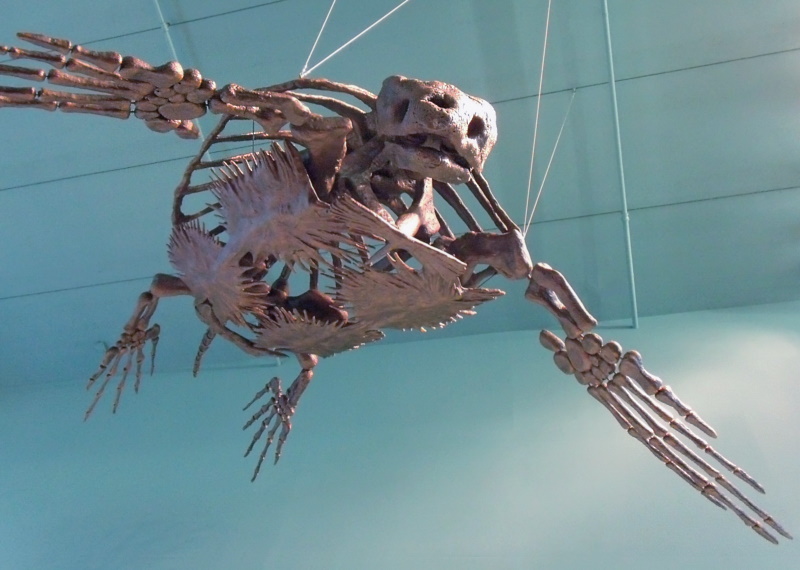
Some ancient sea turtles, while recognizably similar to modern sea turtles, grew to enormous size. A very complete fossil from the Cretaceous of a sea turtle is on display that has a shell 3.6 meters wide. There were other lineages of the anapsids from out of the Permian, but the turtles were the only one among them to survive to the present day.
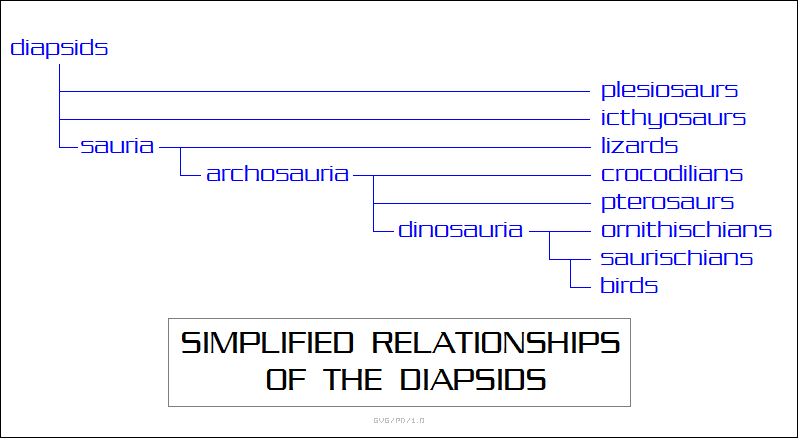
As mentioned earlier, the diapsids were much more the way of the future for the reptilians. The oldest lineages among the diapsids included two aquatic clades, the "sauropterygia" and the "ichthyosaurs".
Early fossil sauropterygians are actually known from the late Permian, though at that time they were almost certainly amphibious creatures, still retaining distinct feet. The family evolved into several subclades during the Triassic:
Plesiosaurs are stereotyped as having long necks, giving them the appearance of the "Loch Ness monster", but a subclade, the "pliosaurs", had a short neck, with a big head full of nasty sharp teeth. A huge skull, 2.4 meters long, discovered in Britain suggested a beast over 15 meters long, a true "sea monster". Another fossil discovered in recent times revealed a mother plesiosaurus with a fetus inside, showing plesiosaurs gave live birth -- before then, it had often been believed they emerged onto land to give birth, like modern sea turtles, though that would have been problematic for the biggest plesiosaurs.
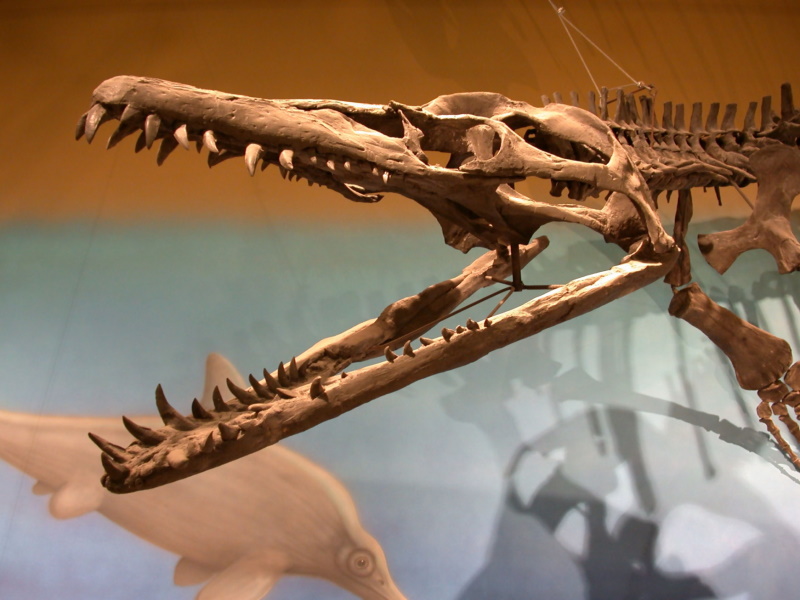
Fossils of the ichthyosaurs are known from the early Triassic. At that time, they were distinctly lizardlike, though with flippers and a modified tail; it seems possible they could have emerged onto land. By the middle of the Jurassic, they had evolved to the streamlined dolphinlike form that was discovered by Mary Anning. As with plesiosaurs, ichthyosaurs bore live young -- as proven by a superlative fossil of an ichthyosaur, still bearing its children. Analysis of the ichthyosaur brain case suggests they had keen senses of sight and smell, their brains being optimized for those senses.
Incidentally, the arbitrary nature of the term "fish" is even more apparent when ichthyosaurs (and the later whales) are considered, since they aren't called "fish", though they're more closely related to a trout than is a shark. Neither the plesiosaurs nor the ichthyosaurs left descendants to the present. The remaining branch of the diapsids, the "sauria", proved more enduring. The sauria include two branches in turn, the "lepidosaurs" and the "archosaurs".
* The lepidosaurs are represented in modern times by two different clades -- one consisting only of the iguanalike "tuatara" of New Zealand, the other consisting of the lizards -- geckos, iguanas and chameleons, skinks, monitor lizards -- and snakes. A snake is effectively a lizard with a lengthened rib cage that has discarded its limbs, and uses the writhing of its body for propulsion. Some modern lizards like skinks hint at the emergence of the snake body, having fairly modest limbs and using body movements to help get around. Fragmentary snake fossils go back about 150 million years, in the Jurassic; a more complete fossil dating from about 120 million years ago, in the Cretaceous, has been found with four little legs. Contemporary pythons have vestigial rear legs, reduced to the status of a "sex toy", used for stimulation during coupling.
Even the biggest modern lizards, the monitors, hardly can compete with the great reptilian dragons of the Mesozoic, but the lizards did produce dragons of their own, in the form of the "mosasaurs", as mentioned originally classified by the Baron Cuvier. The mosasaurs were monitor lizards adapted to an oceanic existence, somewhat along the lines of early ichthyosaurs; they featured elongated bodies, flippers instead of legs, and a tail flattened on the sides to help provide aquatic propulsion.
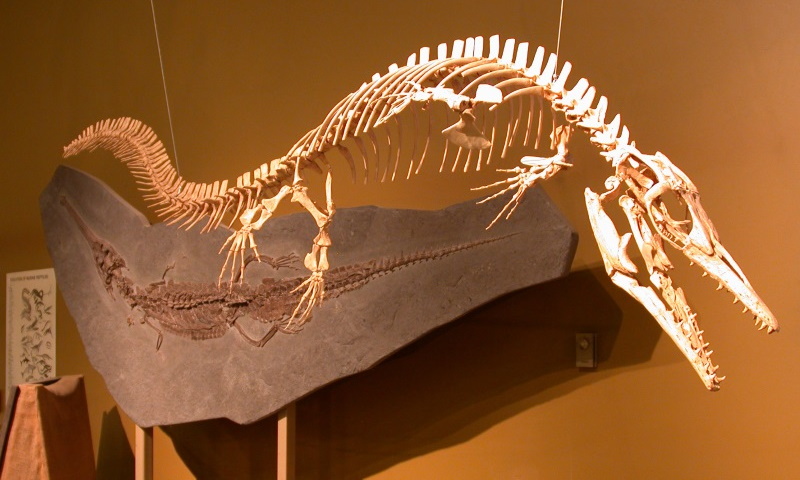
Mosasaurs had a double-hinged jaw and flexible skull, somewhat like that of a snake, presumably to allow them to gulp down large prey whole. Some mosasaurs grew to great size, the largest known being over 17 meters long, though not all were nearly that big. They were well-established by the mid-Cretaceous. Fossils of intermediate beasts known as "aigialosaurs" -- clearly amphibious creatures, bridging the gap between ground-living monitors and the fully aquatic mosasaurs -- are well known.
* The archosaurs proved a diverse group of diapsids. There were a number of early branches that remain obscure and died out, lumped under the paraphyletic name of "thecodonts". Another branch, the "crocodilians", proved more enduring and has survived handily to the present day, in the form of crocodiles, alligators, and the gavials of India with their long snouts full of needle teeth to catch fish.
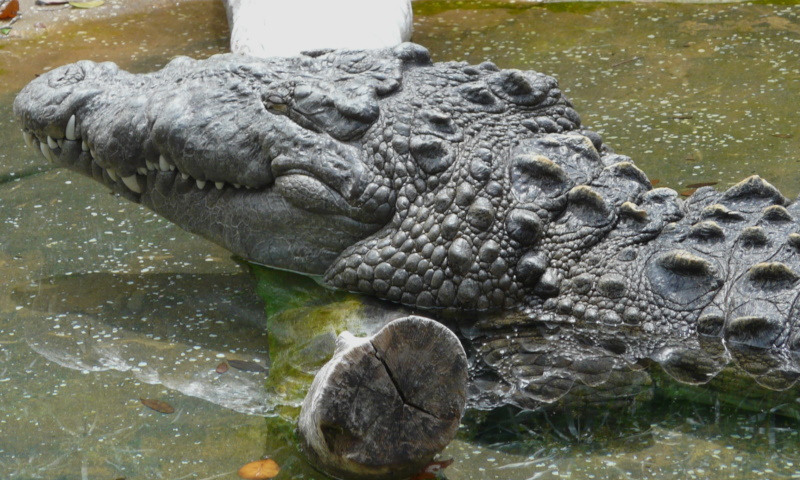
Early crocodilian archosaurs only had some features of modern crocodiles, with short heads, some featuring long legs or even a bipedal configuration, meaning they were fast runners. The distinctive crocodilian form didn't emerge until the Cretaceous, with one ancient member, the Sarchosuchus or "super croc" clearly recognizable as a relative of the modern crocodile, but about 12 meters long. The clade also acquired members, the "dakosaurs", that were adapted for the marine life, resembling the mosasaurs with flippers and flattened tail for swimming -- but with the flattened toothy head we now associate with crocodiles and alligators. They were relatively small compared to the super croc, only up to about 5 meters in length -- though that would make them intimidating enough.
The crocodilian branch off the archosaur base was paralleled by the branch of diapsids that took to the air, the "pterosaurs", sometimes known as the "pterodactyls". They are known from the late Triassic. The wing membrane of the pterosaurs was supported by the vastly stretched fourth digit of the forefeet. No intermediate forms have been found yet, all known pterosaurs having fully developed wings -- but the pterosaurs themselves did evolve, with early pterosaurs having long tails and toothy jaws, while late pterosaurs had reduced tails and, sometimes, no teeth. The pterosaurs appear to have had a hairy covering, but it is thought unlikely that it was much like mammal hair.
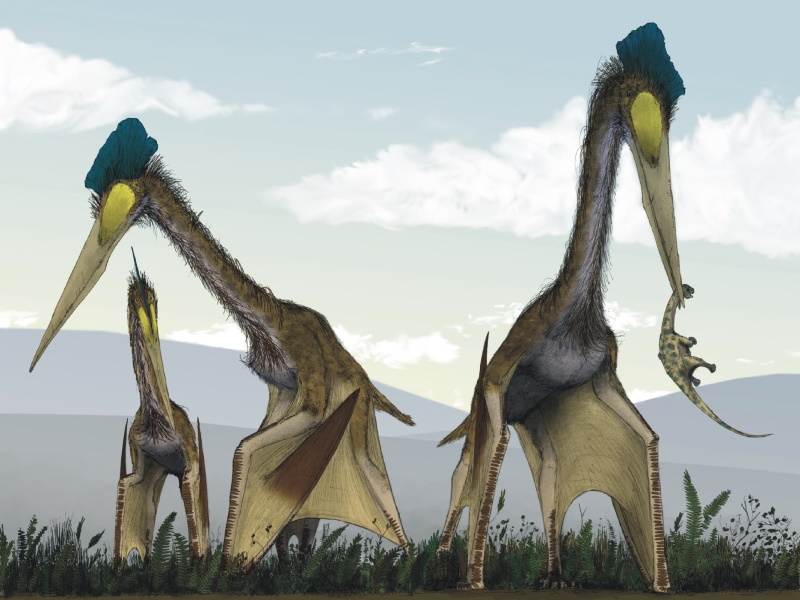
In the late Cretaceous, one branch of the pterosaurs, the "azhdarchids" -- appropriately from the Uzbek word for "dragon" -- grew to enormous size, the most famous representative being Quetzalcoatlus, which had a wingspan of 10 meters; partial fossils of azhdarchids have been found that would be taller than a giraffe while walking on all fours. There is some uncertainty as to whether the azhdarchids could fly, since they were so big -- modern oversized birds like the ostrich are flightless -- but analyses suggest they could; a flapping-wing flight model of an azhdarchid with a wingspan of 6 meters was built, and flew perfectly well. There's been other argument over how the azhdarchids made their living; one of the more interesting is that they were "stalking predators" along the lines of the modern stork, walking over the grasslands and gobbling up incautious prey.
BACK_TO_TOP* The pterosaur branch of the diapsids was paralleled in turn by the best-known group of diapsids, the "dinosaurs". They have a high profile not merely because they tended towards the spectacular in size and features, but also because the fossil record of these beasts is known to a high degree of detail. The dinosaurs emerged in the Triassic, being traditionally sorted into two subclades:
The ornithischians all appear to have been herbivores, and are taxonomically divided into two subclades. The first subclade of ornithischians, both qaudrupeds, included:
It is unclear if the back plates of the stegosaur were for defense, or were for display or thermal protection; it is generally believed that the spiked tail was a weapon. One of Gary Larson's FAR SIDE cartoons of the 1980s presented a caveman performing a briefing to his colleagues, pointing to the spiked tail of a stegosaurus on a presentation slide and saying: "And this end is called the 'thagomizer', after the late Thag Simmons."
Although Larson later apologized for portraying cavemen and dinosaurs as existing at the same time, paleontologists enjoyed the cartoon, and so the spiked tail of the stegosaurus has become widely known as the "thagomizer" -- even being labeled as such in museum displays.
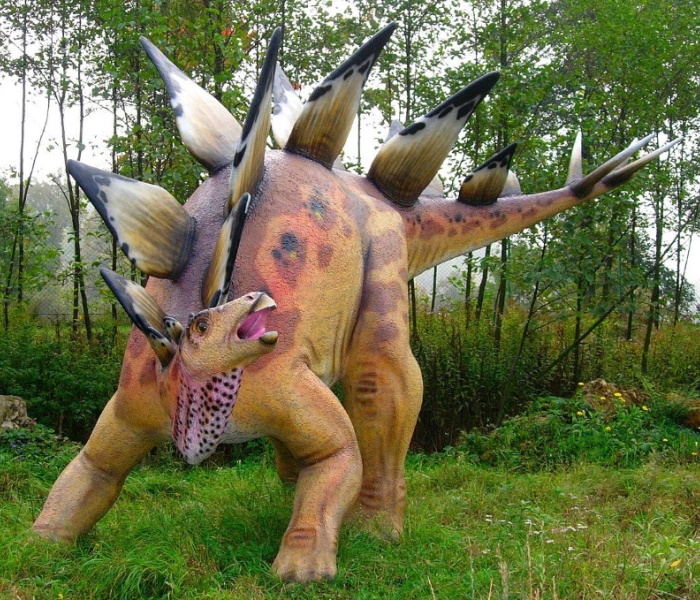
The other subclade of ornithischians included:
Some of the hadrosaurs had elaborate head crest bone structures, the function of which is somewhat unclear. One notion is that the crests were, at least in some cases, resonant chambers to allow the beast to roar more loudly, for mating calls or territorial protection.
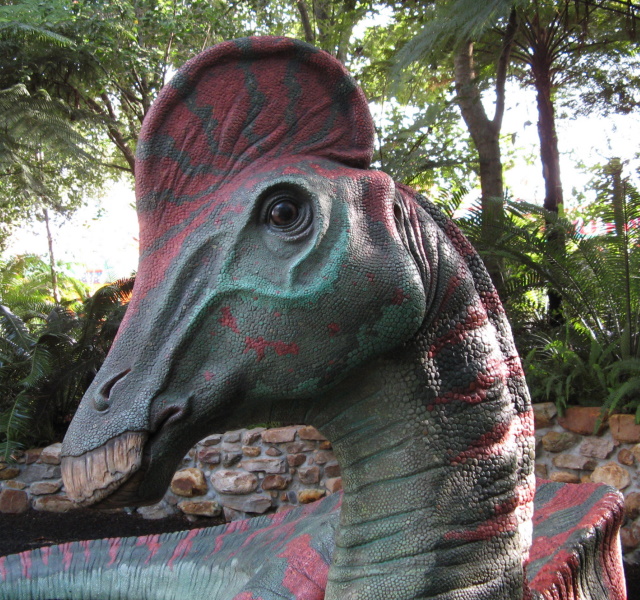
* The saurischians have traditionally been divided into two groups, the first being the "sauropods", the biggest creatures to ever walk on land. They had huge bodies and long necks, represented in the Jurassic by the "apatosaurus" -- better known to the public as the "brontosaurus", there's been waffling on the naming. The biggest sauropods likely weighed about 100 tonnes, about ten times bigger than a modern African elephant. They were all quadrupeds.
The second group of saurischians was the "theropods", which were bipedal, the best known of the lot being the big predatory "carnosaurs" -- represented in the Jurassic by the well-known "allosaurus" and in the Cretaceous by the "tyrannosaur". Thanks to the JURASSIC PARK novels and movies, the smaller "velociraptors" are also well known.
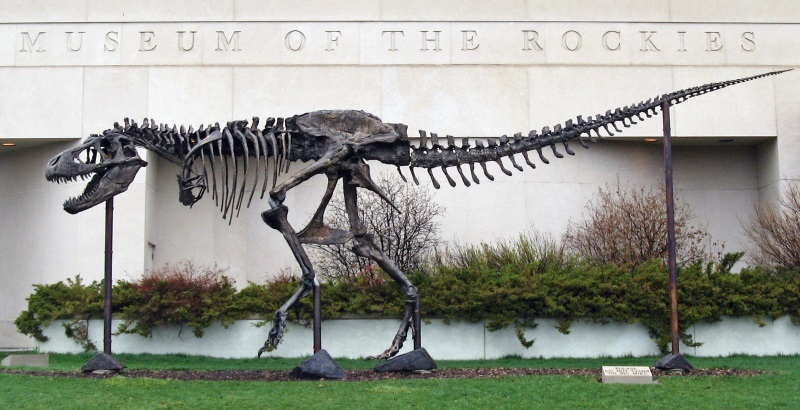
The theropods were not all carnivores, however, with some species having a herbivorous lifestyle. Some were almost ostrichlike, and in fact some smaller theropod species are known from fossil imprints to have had feathers. Indeed, while all the ornithischians and sauropods died out, the theropods have survived and thrived to the present day -- in the familiar form of birds.
There was another group of dinosaurs, the "herrerasaurs", which were relatively small predators, configurationally similar to the theropod predators but clearly distinct from them in morphology. They died out late in the Triassic period. There's no strong consensus on where they fit in the dinosaur family tree, having traditionally regarded as an offshoot of the theropods.
It should be noted that the traditional division between ornithischians and saurischians has been challenged in recent years, with new interpretations suggesting that there really is no saurischian clade; that theropods and ornithischians represent one branch of the dinosaur family tree, while the sauropods -- and the herrerasaurs -- form the other branch. Given that dinosaur taxonomy can only be determined by morphology, there being no way to get genetic data on them, any attempt to overturn the traditional concepts of dinosaur taxonomy is likely to be disputed, and getting a consensus will take time.
BACK_TO_TOP* As mentioned previously, in the 21st century birds are classified among the diapsids, and in fact they are now formally described as dinosaurs. This notion was controversial for decades, it sounded too ridiculous, but as far back as the days of Thomas Huxley there was clear evidence that birds were an offshoot of the dinosaurs. Although there were those who suggested they were an offshoot of the crocodilians or some other diapsid group, the evidence for dinosaur roots kept getting stronger, and under the rules of cladistics, admitting that birds were dinosaurs ultimately became unavoidable. Taxonomy is all about determining family relationships, and if there was to be a family of dinosaurs, it had to include all the members of the family on the family tree. It wasn't arbitrary to include the birds: they're part of the family, it was arbitrary to exclude them.
The only real controversy left over is semantic, there being no major disagreement over the broad path of the evolution of the birds. Although there are a few doubters, birds are generally recognized as descendants of small theropods, and the problem with excluding the birds from the dinosaur group is that they are far more closely related to saurischians than saurischians are to ornithischians.
There is no way to exclude the birds from the dinosaurs without driving a taxonomic wedge between the saurischians and ornithischians. Birds are more closely related to the allosaurus than the allosaurus is to the stegosaurus -- despite the similarity in hip structure, birds are not closely related to the ornithischian dinosaurs. To make the birds even more difficult to extract from the dinosaurs, they are more closely related to the theropods than the theropods are to the big sauropods.
Some biologists with more of a focus on the present than on the past tend to still be uncomfortable with the idea of birds as dinosaurs, finding the association between classic dinosaurs and birds too clashing to be sensible for their purposes. Strict cladists find this resistance puzzling, since none of the classic dinosaurs are around any more to cause confusion, and also point out that crustaceans include such diverse forms as shrimp, barnacles, and parasitic barnacles -- none of which superficially resemble each other at all. However, it's a shrug: by definition of a clade, the dinosaur clade includes the birds, but if people insist on defining a dinosaur grade that excludes them, who would sensibly think it worth their bother to object?
Modern fossil finds of small theoropod dinosaurs known as "dromaeosaurids", most particularly of a species named Sinornithosaurus found in China provide clear impressions of feathers. Early birds like the toothed Archaeopteryx are so similar to the small theropods known as "maniraptors" that if there weren't impressions of feathers and wings in the fossils, they would likely be classified as them. The velociraptor, a maniraptor, may well have had feathers. Larger theropods like the tyrannosaur would not have had feathers, except possibly for ornamentation, since their size would have made heat disposal an issue, with feathers making the problem worse -- in much the same way that modern elephants don't have fur.
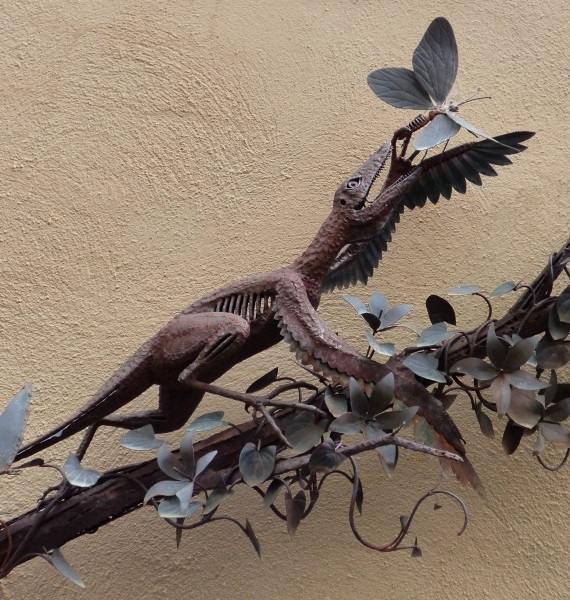
The general modern assumption is that feathers preceded birds, being an adaptation that came in handy as insulation in climates a bit too cool for scaly reptilians, and later acquired roles in camouflage, sexual display, and flight. However, that is an assumption, and it is perfectly possible that at least some of these maniraptors were actually flightless birds, descendants of flying ancestors, and not really part of an ancestral line to the birds. Such are the ambiguities lurking in the fossil record.
It was once thought that feathers were derived from reptilian scales, but that is now argued. The fossil record on the origin of feathers has been becoming more detailed in recent years, both providing some illumination and making things a bit more confusing. There are hints that featherlike structures go back to the basal archosaurs -- as noted, pterosaurs seem to have had hairy coverings that could well be a side branch of feather evolution -- but the fossil remains are ambiguous and in some cases may be artifacts. As far as the protests over classifying birds as dinosaurs go, such considerations are irrelevant, since no matter how feathers got started, birds are still seen as rooted in the theropods.
Teeth were common among early birds and were retained for a long time, so it's a bit surprising that absolutely no modern birds have teeth. They do retain the genes for teeth, however, and bird tissue has been used to produce teeth like those of ancient birds in lab experiments. The only thing that's missing is a single protein, and if a chicken was genetically modified with that protein, it would in fact grow hen's teeth. Ironically, there is an extinct group of birds known as "pelagornithids" that had beaks with toothlike protrusions -- they "re-evolved" teeth again, but significantly, in a very different form than the teeth of their ancestors.
* Incidentally, while not all birds fly, they are generally seen as flying creatures, and how they acquired that trick is something of a mystery. While there was a long-standing assumption that they evolved out of gliding animals, some have argued that this is an evolutionary path unlikely to lead to true flight. The gliders tend to be more reminiscent of parachutes than aircraft, and it is a bit hard to think of a parachute as a direct stepping-stone to an aircraft -- man-made parachutes were around for about a century before humans learned to properly fly. In addition, the changes involved in the transition from a glider to a flapping-wing flier are roughly on the same order of elaboration as those involved in turning a flightless animal into a flapping-wing flier.
A subtler theory suggests that they began as running animals capable of boosting speed or taking to the air every now and then to escape predators, along the lines of the way a quail will run for as long as it can, taking to the air in a burst of energy when pursuit gets too hot. That sort of evolutionary "logic" can be seen in the flying fish, with its aerial leaps from the waves to escape pursuit. Flying fish could never really go on to long-distance flight, however, since they can't live out of the water for long, and the adaptations required for them to do so were just too far outside the potential of the fish form.
A variation on this theory suggests that the "protobirds" flapped their "protowings" to climb trees rapidly. Along the same lines, studies of the behavior of modern small parrots suggest that flapping wings may have been useful in assisting hops from branch to branch in trees, while still being useful for gliding.
A fossil protobird discovered in China in 2000 named Microraptor stirred up excitement in this debate, though it hasn't resolved it. Microraptor had feathered flight surfaces on both its front and back legs, as well as a long feathered tail. Advocates of the glider theory maintain the creature suggests a glider; skeptics say its form was not as well adapted to that role as it might seem. The debate continues.
BACK_TO_TOP* In any case, Archaeopteryx shows that birdlike forms were well-established in the Jurassic. It was not really a modern bird, however, being structurally far more a classic dinosaur than bird. Although it did have feathers, a wishbone, and birdlike feet, as noted it had teeth, claws on the wings, an undeveloped breast structure that limited its flying ability -- and it also a long bony reptilian tail. Given an image of a maniraptor skeleton, an Archaeopteryx skeleton, and a pigeon skeleton, an untrained observer would group the first two skeletons together, and clearly see the pigeon -- with its stubby tail and elaborate breastbone structure -- as a different creature. A trained observer would confirm and reinforce the same grouping.
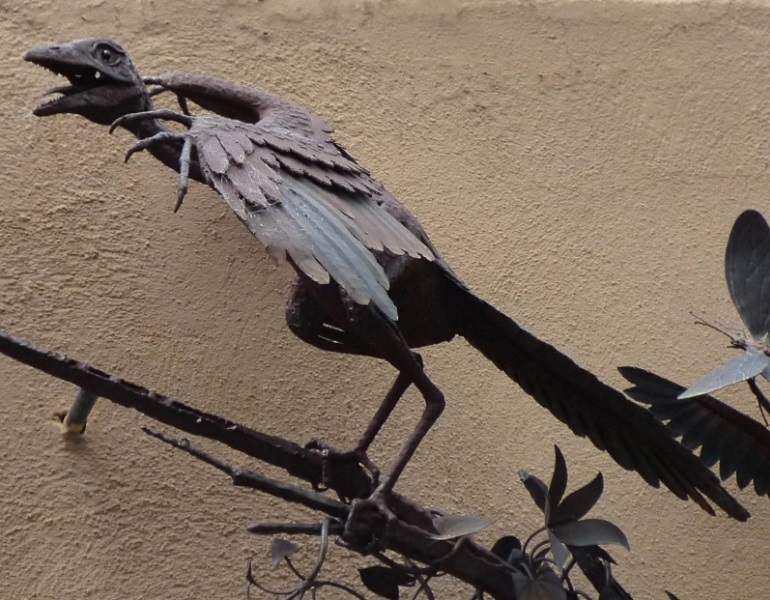
Some creationists deny that Archaeopteryx is an intermediate form to modern birds, insisting that it was really just a bird, it seems because it was fully feathered and had the rough general appearance of a modern bird. They insist that a true "transitional form" would be intermediate in all respects, for example with "intermediate" feathers and "intermediate" wings, but that is a fantasy. In practice, one feature of an organism may evolve in a different sequence and rate than another, a notion referred to as "mosaic evolution". There is no law or logic requiring that all the features we recognize as birdlike had to evolve tidily in parallel.
Creationists also like to insist that Archaeopteryx was not really the ancestor of modern birds. This is obfuscation, showing why, again, the term "intermediate form" is preferred to "missing link": it had a form that was "intermediate", in the sense that it had some features of classic dinosaurs and some of modern birds, but it's difficult to say it was on the direct line of descent to birds. Evolution defines a branching tree of lines of descent; what branch it was on, whether it was a "grandfather" or simply a "grand-uncle" to modern birds is not a significant issue. If it wasn't on the direct line of descent, it is a reasonable inference to assume that there were intermediate "sibling" forms with broadly similar features that were on the direct line of descent to modern birds.
In any case, by the Cretaceous, intermediate forms of birds were on the scene that were much closer to modern birds. Ichthyornis is one well-known example, something like a modern tern, but with teeth. Another familiar example, Hesperornis, had the form of a diving bird something like a modern grebe, except with teeth; it had vestigial wings and couldn't fly, though they might have served a control function in dives. Both had most of the features of modern birds.
* In modern times, birds consist of two major clades, including the "paleognathans" or "ratites" -- ostriches, emus, rheas, the huge extinct moas of New Zealand and elephant birds of Madagascar, kiwis, and the obscure tinamous -- and the "neognathans", or everything else. The ancestors of the ratite branch clearly go back to the age of dinosaurs, since they are effective globally distributed even though few ratites can fly or, as far as the fossil record goes, have been able to fly for a long time. Their origins trace back to the days of the breakup of Pangaea, which began about 175 million years ago, and they would end up with a far-flung distribution.
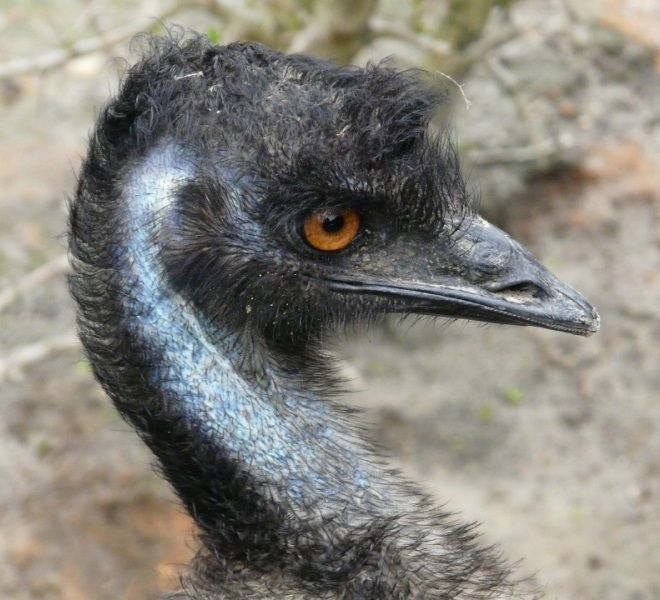
The neognathans split in turn into two subclades: the "galloanseres", meaning the fowls and waterfowls; and the "neoaves", which covers everything else. This split is generally believed to have taken place in the late Mesozoic. The fowls include pheasants, quail, partridges, turkeys, and so on, while the waterfowls include ducks, geese, and swans. There's some interesting side branches within the waterfowls, for example the "whistling ducks" of South America, which are duck-sized but have long necks and legs like geese, and produce a laughing sound -- "WHEE HEE HOO! WHEE HEE HOO!" -- instead of the stereotypical duck quack.
As far as neoaves go, there were uncertainties in their relationships, which were generally resolved by a thorough genetic analysis of bird species, producing a few surprises. Neoaves is split into two groups, including "columbea", meaning doves, flamingoes, and grebes; and "passerea", which includes everything else. The passerea groups can be loosely arranged as follows:
Birds did not reach their level of modern diversification during the age of the dinosaurs; they came later, along with some interesting extinct lineages, such as the "terror birds" of South America, which were oversized flightless predators with great sharp beaks and meathook claws on their stubby wings, amounting to something of a "re-invention" of their theropod ancestors. The same rough configuration survives today in substantially smaller forms of ground-living predatory birds, such as the South American crested seriema and the secretary bird of Africa.
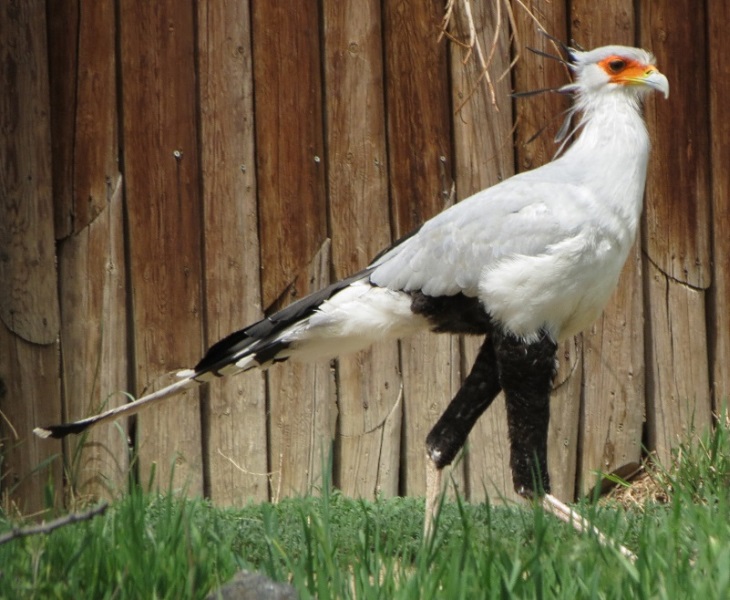
In short, the dinosaurs never did go extinct, and in fact they are still thriving, even in the modern era when species diversity is clearly on the decline.
BACK_TO_TOP* While the scenery of the Mesozoic might have been dominated by reptilians, they were by no means the only items of interest on the landscape. In particular, modern plants arose during that time in the form of the "angiosperms" or flowering plants, which emerged in the Cretaceous.

Before that time the world had no flowers, with plants generally spreading their pollen to the wind, an inefficient process that tended to cluster plants in stands. Thanks to the co-evolution of pollinators such as bees, the angiosperms acquired "agents" that could transfer pollen far and wide, helping them to become the dominant land plants. The angiosperms became a diverse group, with their flowers complemented by schemes for the distribution of seeds, such as berries and fruits -- which would be eaten by birds and the like, with the seeds then excreted some distance from the parent plant -- or cockleburrs and the like, to cling onto beasts and be carried some distance. In addition, the angiosperms developed a wide range of defenses, based on spines or toxins.

Water lilies are regarded as among the most "primitive" flowering plants; more recent arrivals cover a massive range of forms. Traditionally, the angiosperms were divided into two groups, the "monocots" and the "dicots". The difference between the two hinges on early development, and is somewhat along the lines of the division between protostomes and deuterostomes in animals: when angiosperm seedlings germinate, they can start out with one leaf, making them monocots, or with two leaves, making them dicots. The monocots include:
The dicots could then be described as "all the other angiosperms" -- except for the fact that from what we know now, it turns out to be not quite so simple. The division of angiosperms into monocots and dicots works out fairly well as a practical measure, but modern research has shown the dicots to be diverse; there's a "primitive" group of dicots, whose modern descendants are limited to the water lilies and the pepper plants, that gave rise to both the monocots and all the other dicots. Since monocots are derived from dicots, the "monocots versus dicots" distinction is meaningless from a cladistic point of view.
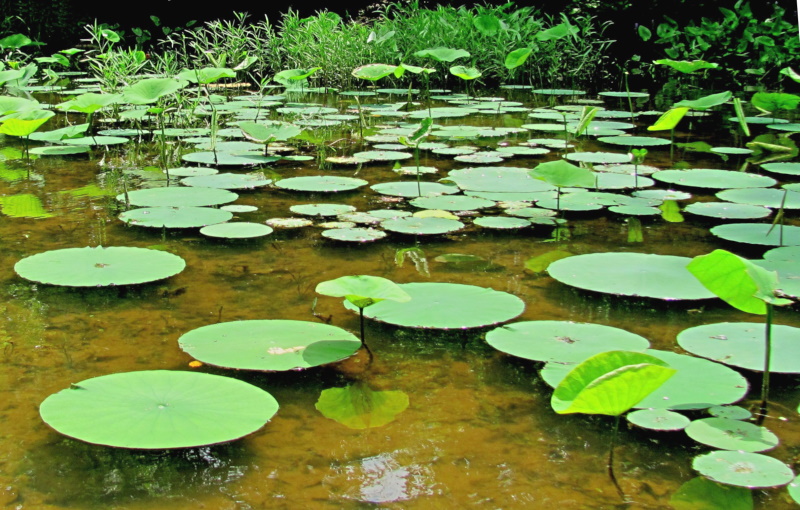
While monocots still constitute a clade, dicots have been divided into a handful of separate clades. Not surprisingly, there's some argument over how many, but the dicots can be roughly broken down into four groups:
There are well more species of eudicots than species of all other angiosperms combined, meaning that, while the "monocots versus dicots" division is misleading, the angiosperms could be usefully organized at a simple level as "eudicots, monocots, and some spare change." The eudicots include many well-known groups of plants, some of the groups being astonishingly diverse in themselves, featuring well-known modern species including:
* Of course, flowers implied the rise of pollinators to feed on them and transfer pollen between them, with the Mesozoic seeing the rise of butterflies and bees. Bees, incidentally, are derivatives of wasps, which were originally a predatory group, though some wasp species today are pollinators; also incidentally, ants are wasps that (usually) can't fly. Insects had a tendency to become trapped in pitch, which in some cases solidified into stony amber, leaving behind superlative fossils.
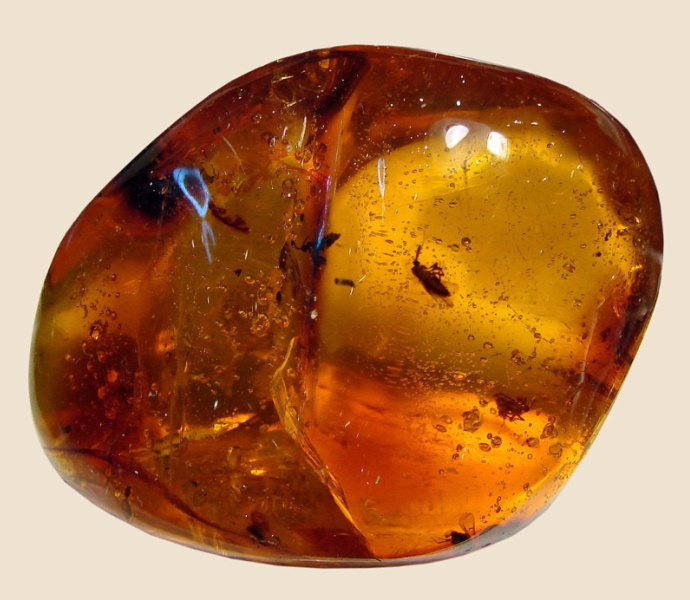
Other groups of invertebrates emerged in the Mesozoic, one of the most significant being the common "ammonites", which were cephalopods like squids but with coiled shells like nautiloids. As far as vertebrates went, jumping frogs much like modern frogs emerged. Most significantly, mammals also became common during the Mesozoic -- in fact, despite the dominance of reptilians during the era, they were common all through the Mesozoic. However, they seem to have been generally niche players, with no fossils known of creatures any larger than a cat. They did have some range of interesting features, with one detailed fossil revealing a little beast, Volaticotherium, that was along with lines of a flying squirrel, with flaps of skin between its front and back legs to allow it to glide from tree to tree.
As mentioned, mammals were an offshoot of the cynodont synapsids. Relics of the early days of mammals survive, in the form of the "monotremes" of New Zealand like the platypus that lay eggs but give milk to their young. It should be noted that mammals are classified as "amniotes", even though only the monotremes lay eggs, because all the mammals are descendants of amniote egg-layers -- in the same way that a snake is classified as a "tetrapod".
In the case of the platypus, however, except for its "primitive" inclination to lay eggs, it cannot be considered a "living fossil" in any way, instead being an animal with unusual and elegant adaptations -- sporting webbed feet, an ultrasensitive toothless "duckbill" for hunting worms and the like in dark brackish water, and (for the males) venom spurs on the hind feet. It was once seen as made up from the spare parts of other animals as if it were some sort of monster created by a mad scientist -- but it is as suited to the niche it occupies as, say, whales are to theirs.
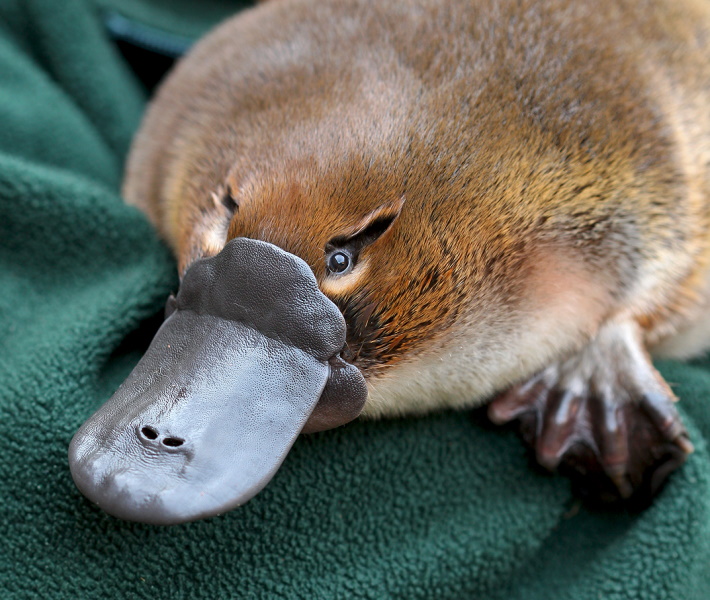
The age of dinosaurs also saw the introduction of the other two surviving branches of the family of mammals, the "marsupials" like the kangaroo and opossum -- which give birth to young in a near-embryonic state after a short and convenient gestation period -- and the "placental" mammals, which give birth to generally developed young after a long gestation period, the offspring being linked to the mother in the womb by a link known as a "placenta".
The most common mammals of the era were actually the "multituberculates", mostly rodent-like creatures, all now vanished, distinct from the marsupials but with much in common with them. Mammals, not incidentally, were around from early in the age of the dinosaurs, from the early Jurassic, but as far as the fossil record shows they were relatively small players, with none from that time found so far much bigger than a modern housecat. Given their antiquity, there must have been a fair diversity of forms in those times, but small animals don't preserve well as fossils and so the record is sketchy.

The Mesozoic came to an abrupt end 65 million years ago. The general consensus for some years was that a giant meteor impact that hit in what is now the Yucatan Peninsula causes a wave of burning, followed by a long winter and a climatic shift. The impact clearly occurred, but there has been considerable debate among geologists and paleontologists whether it was really responsible for the mass extinction. Climate up to the impact appears to have become very unstable, and there is evidence of a massive burst of volcanic eruptions in what is now India, creating a widespread lava field called the "Deccan Traps". From the point of view of evolutionary science, the debate is a shrug: everybody agrees there was a mass extinction, the argument is just over the cause. Once again, the new world would look very different from that which came before.
BACK_TO_TOP